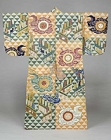Japanese Gallery (Honkan) Room 9
June 19, 2007 (Tue) - August 19, 2007 (Sun)
Noh drama is thought to have originated as a performing art to bless the land and pray for a rich harvest. Waki-noh, the opening plays in a day of Noh performances, seem to retain the art's original nature; their contents are related to the origins of Buddhist temples or Shinto shrines, and bless the land of Japan and hope for a rich harvest. "Kamo" is one of waki-noh set at the Shimogamo shrine in Kyoto.
The story involves a priest from Murono Myojin shrine in Harima province (present Hyogo prefecture) who visited the Shimogamo (Lower Kamo) Shrine near the Kamo River. He met two women at the river who were fetching water to offer the deity of Shimogamo shrine. When the priest asked them about the shrine's origins, they explained:
The priest wondered about the two women, however, they turned into deities and disappeared. Shortly after this the mother deity of Shimogamo shrine (wearing choken and oguchi garments, a zo-onna mask and a crown) appeared and danced a heavenly woman's dance. Later, when the mother deity was soaking her sleeves in the cool river, thunder rumbled and rain started to fall as the thunder god (wearing otobide mask with golden skin and bulging eyes, and a gold brocade kariginu under atsuita garment) emerged from the sky. The thunder god showed his overwhelming power and explained to the priest about the virtue of gods that protect Japan. Then the mother deity retired into the shrine's forest and the thunder god returned to heaven. The rumbling of the thunder god's drum is thought to be a celebration in advance of a bountiful harvest.

